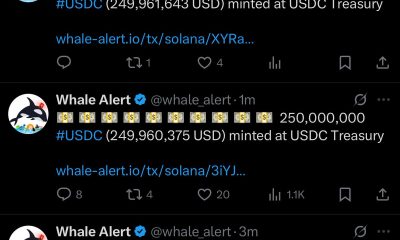

others
USD/INR recovery loses steam, eyes on Indian WPI inflation, US Retail Sales – Crypto News
- Indian Rupee attracts some buyers, supported by the upbeat Indian CPI inflation data and foreign inflows.
- Risk-averse sentiment and the possible intervention from the Indian central bank might limit the upside of INR.
- Market players await the Indian WPI inflation and US Retail Sales for February, due on Thursday.
Indian Rupee (INR) trades on a positive note on Wednesday. The upbeat Indian Retail Inflation data for February provides some support to the local currency and drags the USD/INR pair lower. The recovery of INR is also bolstered by persistent foreign inflows in domestic equity markets. However, the renewed US Dollar (USD) demand from importers, risk-averse sentiment, and the potential intervention from the Reserve Bank of India (RBI) might cap the upside of the Indian Rupee.
Looking ahead, investors will monitor India’s Wholesale Price Index (WPI) of Food, Fuel, and Inflation on Thursday. On the US docket, US Retail Sales will be in the spotlight later on Thursday. The Retail Sales figure is estimated to improve to 0.8% MoM in February from a 0.8% drop in January.
Daily Digest Market Movers: Indian Rupee remains stronger amid multiple headwinds
- India’s Retail inflation eased to 5.09% YoY in February from 5.10% in the previous month, better than the market expectation of 5.02%, according to the Ministry of Statistics & Programme Implementation.
- The Indian food inflation for February came in at 8.66% versus 8.30% prior. Meanwhile, the rural inflation rate remained steady at 5.34%, while the urban inflation rate declined to 4.78% from 4.92% in January.
- India’s Industrial Production dropped to 3.8% YoY in January from the previous reading of 4.2%, stronger than estimated.
- The US headline Consumer Price Index (CPI) came in line with expectations, rising 0.4% MoM in February. The annual CPI figure was above the market consensus, increasing 3.2% YoY in February.
- The Core CPI, excluding volatile food and energy prices, climbed 0.4% MoM and 3.8% YoY, above the market consensus.
- The upbeat inflation data might convince the Fed to focus on more data and allow policymakers to avoid having to rush to cut rates.
Technical Analysis: Indian Rupee remains capped within longer term trading band
Indian Rupee trades strongly on the day. USD/INR has stayed within a multi-month-old descending trend channel around 82.60–83.15 since December 8, 2023.
The bearish outlook of USD/INR remains intact in the near term as the pair is below the 100-day Exponential Moving Average (EMA) on the daily timeframe. Furthermore, the downward momentum is supported by the 14-day Relative Strength Index (RSI), which lies below the 50.0 midlines, indicating the downtrend is more likely to resume than to reverse.
The lower limit of the descending trend channel at 82.60 acts as a potential support level for the pair. A breach of this level could sustain a bearish drop to a low of August 23 at 82.45, followed by a low of June 1 at 82.25.
On the upside, a decisive break above the confluence of the 100-day EMA and a psychological round mark of 83.00 could make its way back up to the upper boundary of the descending trend channel at 83.15. A bullish breakout above 83.15 will expose a high of January 2 at 83.35, en route to the 84.00 round figure.
US Dollar price this week
The table below shows the percentage change of US Dollar (USD) against listed major currencies this week. US Dollar was the weakest against the Swiss Franc.
| USD | EUR | GBP | CAD | AUD | JPY | NZD | CHF | |
| USD | 0.14% | 0.47% | 0.07% | 0.17% | 0.42% | 0.28% | 0.01% | |
| EUR | -0.14% | 0.32% | -0.08% | 0.03% | 0.28% | 0.15% | -0.13% | |
| GBP | -0.47% | -0.33% | -0.41% | -0.30% | -0.05% | -0.18% | -0.46% | |
| CAD | -0.06% | 0.07% | 0.40% | 0.10% | 0.33% | 0.21% | -0.06% | |
| AUD | -0.18% | -0.02% | 0.31% | -0.13% | 0.25% | 0.12% | -0.16% | |
| JPY | -0.40% | -0.28% | 0.30% | -0.35% | -0.24% | -0.13% | -0.41% | |
| NZD | -0.28% | -0.15% | 0.18% | -0.23% | -0.12% | 0.13% | -0.28% | |
| CHF | -0.01% | 0.13% | 0.46% | 0.06% | 0.16% | 0.39% | 0.28% |
The heat map shows percentage changes of major currencies against each other. The base currency is picked from the left column, while the quote currency is picked from the top row. For example, if you pick the Euro from the left column and move along the horizontal line to the Japanese Yen, the percentage change displayed in the box will represent EUR (base)/JPY (quote).
Indian economy FAQs
The Indian economy has averaged a growth rate of 6.13% between 2006 and 2023, which makes it one of the fastest growing in the world. India’s high growth has attracted a lot of foreign investment. This includes Foreign Direct Investment (FDI) into physical projects and Foreign Indirect Investment (FII) by foreign funds into Indian financial markets. The greater the level of investment, the higher the demand for the Rupee (INR). Fluctuations in Dollar-demand from Indian importers also impact INR.
India has to import a great deal of its Oil and gasoline so the price of Oil can have a direct impact on the Rupee. Oil is mostly traded in US Dollars (USD) on international markets so if the price of Oil rises, aggregate demand for USD increases and Indian importers have to sell more Rupees to meet that demand, which is depreciative for the Rupee.
Inflation has a complex effect on the Rupee. Ultimately it indicates an increase in money supply which reduces the Rupee’s overall value. Yet if it rises above the Reserve Bank of India’s (RBI) 4% target, the RBI will raise interest rates to bring it down by reducing credit. Higher interest rates, especially real rates (the difference between interest rates and inflation) strengthen the Rupee. They make India a more profitable place for international investors to park their money. A fall in inflation can be supportive of the Rupee. At the same time lower interest rates can have a depreciatory effect on the Rupee.
India has run a trade deficit for most of its recent history, indicating its imports outweigh its exports. Since the majority of international trade takes place in US Dollars, there are times – due to seasonal demand or order glut – where the high volume of imports leads to significant US Dollar- demand. During these periods the Rupee can weaken as it is heavily sold to meet the demand for Dollars. When markets experience increased volatility, the demand for US Dollars can also shoot up with a similarly negative effect on the Rupee.
-

 Technology1 week ago
Technology1 week agoChatGPT users are mass cancelling OpenAI subscriptions after GPT-5 launch: Here’s why – Crypto News
-

 Technology7 days ago
Technology7 days agoiPhone 17 series tipped to cost more than iPhone 16: Here’s how much it could cost in India and US – Crypto News
-

 Cryptocurrency1 week ago
Cryptocurrency1 week agoXRP gains legal clarity in US after Ripple settles SEC case – Crypto News
-
Cryptocurrency1 week ago
DWP Management Secures $200M in XRP Post SEC-Win – Crypto News
-
others5 days ago
Breaking: USDC Issuer Circle To Launch Arc Blockchain for Stablecoin Payments – Crypto News
-
others1 week ago
SEC Latest Filing Reveal Ripple Case Win Could Trigger XRP Treasury Boom Like Ethereum – Crypto News
-

 Technology1 week ago
Technology1 week agoHumanoid Robots Still Lack AI Technology, Unitree CEO Says – Crypto News
-

 De-fi1 week ago
De-fi1 week agoRipple Expands Its Stablecoin Payments Infra with $200M Rail Acquisition – Crypto News
-

 Cryptocurrency1 week ago
Cryptocurrency1 week agoHarvard Reveals $116 Million Investment in BlackRock Bitcoin ETF – Crypto News
-
Business1 week ago
Trump’s World Liberty Financial Targets $1.5B Crypto Vehicle Backed by WLFI Tokens – Crypto News
-

 Technology5 days ago
Technology5 days agoSam Altman drops major GPT 5 update, unveils Auto, Fast and Thinking as response modes to choose; check rate limits here – Crypto News
-
Technology3 days ago
99% Approval Odds? How Close Are We to Spot Solana ETF Launch in US? – Crypto News
-

 Blockchain1 week ago
Blockchain1 week agoSei Network Gets MetaMask Support as Buy Signals Emerge for SEI Token, $0.5 on the Horizon – Crypto News
-

 others1 week ago
others1 week agoRipple To Gobble Up Payments Platform Rail for $200,000,000 To Support Transactions via XRP and RLUSD Stablecoin – Crypto News
-

 Cryptocurrency1 week ago
Cryptocurrency1 week agoBTC hovers at $115K; ETF flows turn negative, short-term holder profitability drops – Crypto News
-

 De-fi1 week ago
De-fi1 week agoCircle Mints About $1 Billion in USDC After Flurry of Treasury Moves – Crypto News
-
others1 week ago
Crypto Adviser Bo Hines Move to AI Role Sparks Concern Over White House Policy Shift – Crypto News
-
others1 week ago
United Kingdom CFTC GBP NC Net Positions fell from previous £-12K to £-33.3K – Crypto News
-

 Technology1 week ago
Technology1 week agoGPT-5 brings four new personalities to ChatGPT: what they do and how to use them — check our step-by-step guide – Crypto News
-
Business1 week ago
OpenAI Launches GPT-5 Amid Competition From Elon Musk’s Grok – Crypto News
-

 Blockchain1 week ago
Blockchain1 week agoCourt Approves SEC And Ripple’s Joint Motion to Drop Appeals – Crypto News
-
Technology1 week ago
Breaking: XRP Lawsuit Ends as Ripple and SEC File Joint Dismissal – Crypto News
-

 Technology1 week ago
Technology1 week agoHulu app to shut down in 2026 as Disney fully merges platform into Disney+ – Crypto News
-
Technology1 week ago
Trump Removes IRS Commissioner, Pro Crypto Scott Bessent to Serve as Acting Head – Crypto News
-

 Cryptocurrency1 week ago
Cryptocurrency1 week ago$4.5M rug pull? – CrediX disappears while NFTs outpace DeFi – Crypto News
-

 Cryptocurrency7 days ago
Cryptocurrency7 days agoCrypto investors hopeful amid new regulatory orders – Crypto News
-
Business6 days ago
Uniswap Proposes DUNI Legal Entity in Wyoming to Boost DAO Governance – Crypto News
-

 Cryptocurrency6 days ago
Cryptocurrency6 days agoMetaplanet Adds 518 BTC, Now Holds $1.85 Billion Worth of Bitcoin – Crypto News
-
Cryptocurrency5 days ago
Trump Mulls Lawsuit Against Powell Amid Fed Rate-Cut Push – Crypto News
-
others4 days ago
Breaking: Bitcoin Price Hits New All-Time High As Traders Price In Rate Cut – Crypto News
-

 Technology4 days ago
Technology4 days agoGenerative AI set to improve banking operations in India by 46%: RBI Report – Crypto News
-
Business3 days ago
Breaking: U.S. Bitcoin Reserves Worth Up To $20 Billion, Scott Bessent Confirms – Crypto News
-
others3 days ago
Binance Coin Price Eyes $1K on BNB Treasury Boom, ETF Approval Hopes – Crypto News
-

 Cryptocurrency2 days ago
Cryptocurrency2 days agoAltcoins soar, Bitcoin stalls as Fed rate cut speculation hits fever pitch – Crypto News
-

 others1 week ago
others1 week agoUS City Handing $2,000,000 to Residents After New Guaranteed Income Plan Approved – Crypto News
-
others1 week ago
Michael Saylor Predicts Capital To Flow From Gold to Bitcoin Amid Tariff Rumors – Crypto News
-

 Cryptocurrency1 week ago
Cryptocurrency1 week agoThis Ripple (XRP) Metric Flashes Critical Warning Sign – Crypto News
-
Technology1 week ago
Ripple’s 4-Year Lawsuit Battle with the SEC Ends: Timeline, Turning Points, and the Final Verdict – Crypto News
-
Business1 week ago
Ethereum Co-Founder Moves 9,840 ETH as Ethereum Hits New 2025 High – Crypto News
-

 Technology1 week ago
Technology1 week agoInfinix Hot 60i 5G with 6,000mAh battery, MediaTek SoC to launch in India soon: Expect price, specs and more – Crypto News
-

 Technology7 days ago
Technology7 days agoApple’s revamped Siri set for 2026 launch with powerful new App Intents feature: Here’s what it will do – Crypto News
-

 Blockchain6 days ago
Blockchain6 days agoBitcoin Miner MARA Holdings Buys 64% Stake in AI And HPC Firm Exaion – Crypto News
-

 Cryptocurrency6 days ago
Cryptocurrency6 days agoDid crypto just have its LLC moment? – Crypto News
-
Technology6 days ago
A New RWA Project Launches Platform to Challenge VC Dominance in Crypto Startup Funding – Crypto News
-
others6 days ago
Canary Capital CEO Says XRP ETF Will Surpass ETH ETFs as SEC Confirms Lawsuit End – Crypto News
-

 Technology5 days ago
Technology5 days agoiPhone 17 Pro’s new camera design could also boost cellular performance, lower latency: Here’s what we know – Crypto News
-

 De-fi5 days ago
De-fi5 days agoUS Subsidiary of Early Chinese Game Dev Snail Digital Explores Stablecoin – Crypto News
-

 Blockchain5 days ago
Blockchain5 days agoStripe Developing Blockchain in Tandem With VC Firm Paradigm – Crypto News
-

 Blockchain4 days ago
Blockchain4 days agoHow Blockchain Network Layers Apply Across CFO Tech Stacks – Crypto News
-
Business4 days ago
Bullish IPO: BLSH Stock Surges Following Crypto Exchange’s Debut On NYSE – Crypto News





![Car Group Limited – CAR Elliott Wave technical analysis [Video]](https://dripp.zone/news/wp-content/uploads/2025/05/Car-Group-Limited-–-CAR-Elliott-Wave-technical-analysis-Video-400x240.jpg)
![Car Group Limited – CAR Elliott Wave technical analysis [Video]](https://dripp.zone/news/wp-content/uploads/2025/05/Car-Group-Limited-–-CAR-Elliott-Wave-technical-analysis-Video-80x80.jpg)